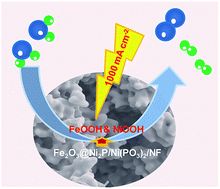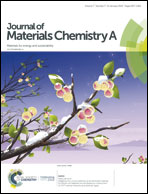A strongly coupled 3D ternary Fe2O3@Ni2P/Ni(PO3)2 hybrid for enhanced electrocatalytic oxygen evolution at ultra-high current densities†
Abstract
Developing highly efficient non-noble metal electrocatalysts for the oxygen evolution reaction (OER) at large current densities remains a challenge for water electrolysis. Herein, we developed a novel 3D ternary hybrid electrocatalyst consisting of Fe2O3 strongly coupled with Ni2P/Ni(PO3)2 grown on commercial Ni foam (denoted as Fe2O3@Ni2P/Ni(PO3)2/NF) through a thermal phosphorization reaction. In this 3D hybrid structure, the Fe2O3@Ni2P/Ni(PO3)2 nanoparticles with a length of ∼300 nm and width of ∼200 nm are homogeneously grown on the surface of 3D Ni foam. Owing to the synergistic effect between Fe2O3@Ni2P/Ni(PO3)2/NF and their strong coupling effect, the 3D Fe2O3@Ni2P/Ni(PO3)2/NF hybrid achieves a superior electrocatalytic OER performance at ultra-high current densities in alkaline electrolyte. High catalytic current densities of 500 and 1000 mA cm−2 are reached by applying only potentials of 1.57 and 1.60 V, respectively, which are almost the lowest potentials among all previously reported transition metal (Ni and Fe) based phosphide and phosphate electrocatalysts, and even better than that of the benchmark Ir/C catalyst (1.64 and >1.8 V at 100 and 500 mA cm−2). In situ Raman spectroscopy revealed that the NiOOH and FeOOH species were the real active phases in Fe2O3@Ni2P/Ni(PO3)2/NF during the OER process. A two-electrode electrolyzer with Fe2O3@Ni2P/Ni(PO3)2/NF delivers a cell voltage of 1.93, 2.48, and 3.02 V at 100, 500, and 1000 mA cm−2 for overall-water-splitting.



 Please wait while we load your content...
Please wait while we load your content...